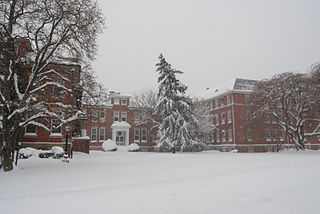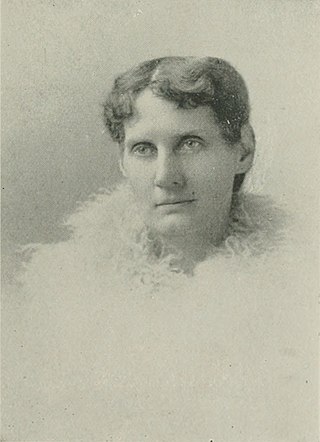Related Research Articles

NYC Health + Hospitals, officially the New York City Health and Hospitals Corporation (HHC), operates the public hospitals and clinics in New York City as a public benefit corporation.

Barnwood House Hospital was a private mental hospital in Barnwood, Gloucester, England. It was founded by the Gloucester Asylum Trust in 1860 as Barnwood House Institution and later became known as Barnwood House Hospital. The hospital catered for well-to-do patients, with reduced terms for those in financial difficulties. It was popular with the military and clergy, and once counted an archbishop amongst its patients. During the late nineteenth century Barnwood House flourished under superintendent Frederick Needham, making a healthy profit and receiving praise from the Commissioners in Lunacy. Even the sewerage system was held up as a model of good asylum practice. After the First World War service patients, including war poet and composer Ivor Gurney, were treated with a regime of psychotherapy and recreations such as cricket.

The Crownsville Hospital Center was a psychiatric hospital located in Crownsville, Maryland. It was in operation from 1911 until 2004.

Creedmoor Psychiatric Center is a psychiatric hospital at 79-26 Winchester Boulevard in Queens Village, Queens, New York, United States. It provides inpatient, outpatient and residential services for severely mentally ill patients. The hospital occupies more than 300 acres (121 ha) and includes more than 50 buildings.

Kings County Hospital Center is a municipal hospital located in the East Flatbush neighborhood of Brooklyn, New York City. It is owned and operated by NYC Health + Hospitals, a municipal agency that runs New York City's public hospitals. It has been affiliated with SUNY Downstate College of Medicine since Downstate's founding as Long Island College Hospital in 1860. Kings County is a member of the New York City Health and Hospitals Corporation.

NYC Health + Hospitals/South Brooklyn Health is a public teaching hospital located in the Coney Island neighborhood of Brooklyn, New York City. It is owned by NYC Health + Hospitals, a public benefit corporation of the city. The hospital is home to FDNY-EMS Station 43, formerly NYC-EMS Station 31, and is a major clinical affiliate for clinical clerkship with the New York Institute of Technology College of Osteopathic Medicine.
Mendota Mental Health Institute (MMHI) is a public psychiatric hospital in Madison, Wisconsin, United States, operated by the Wisconsin Department of Health Services. The hospital is accredited by the Joint Commission. Portions of the facility are included in the Wisconsin Memorial Hospital Historic District, District #88002183. The Mendota State Hospital Mound Group and Farwell's Point Mound Group are also located at the facility.

The Mount Sinai Health System is a hospital network in New York City. It was formed in September 2013 by merging the operations of Continuum Health Partners and the Mount Sinai Medical Center.

Central institute of Psychiatry Ranchi is an institute that is directly governed by the Government of India. It is situated in Kanke, Ranchi in Jharkhand state of India.
Winfred Overholser was an American psychiatrist, president of the American Psychiatric Association, and for 25 years the superintendent of St. Elizabeths Hospital, a federal institution for the mentally ill in Washington, D.C.

Queens Hospital Center (QHC), also known as NYC Health + Hospitals/Queens and originally called Queens General Hospital, is a large public hospital campus in the Jamaica Hills and Hillcrest neighborhoods of Queens in New York City. It is operated by NYC Health + Hospitals, a public benefit corporation of the city.
Hendrika Bestebreurtje Cantwell is a German-born American retired physician, professor emerita of pediatrics at the University of Colorado Denver, advocate for abused and neglected children, and parenting educator. She was one of the first physicians in the United States to work for a child protection agency, serving with the Denver Department of Social Services from 1975 to 1989. Her work there brought her in contact with an estimated 30,000 cases of suspected child abuse and she testified as an expert witness in thousands of court cases. An author of peer-reviewed journal articles, book chapters, and teaching manuals on the detection and treatment of child abuse, she has also conducted workshops and training programs for professionals throughout Colorado. She was inducted into the Colorado Women's Hall of Fame in 1990.

St Barnabas Hospital is a non-profit teaching hospital founded in 1866. The hospital is located in the Belmont neighborhood of The Bronx in New York City. It is a level II adult trauma center and is a major clinical affiliate for clinical clerkship of the New York Institute of Technology College of Osteopathic Medicine.

Neponsit Beach Hospital, also known as Neponsit Beach Hospital for Children, Neponsit Hospital, Neponsit Children's Hospital, and various other names, is a former municipal tuberculosis sanatorium located adjacent to Jacob Riis Park and the Neponsit community on the western end of the Rockaway peninsula in Queens, New York City. Originally oriented towards the treatment of children, the hospital treated military veterans during and after World War II, but closed in 1955 due to a declining need for tuberculosis hospitals. Afterwards, it operated as the Neponsit Home for the Aged, later the Neponsit Health Care Center, a city-run nursing home until its controversial closure in 1998. The hospital was demolished in 2023.

Lucy M. Hall-Brown was an American physician and writer. She was a general practitioner and a physician at the Sherborn Reformatory for Women, now the Massachusetts Correctional Instituion – Framingham.

Simon Risefeld Blatteis was an Austrian-born American pathologist and professor of medicine who led several efforts against infectious disease in New York. He was a leading organizer of New York City's Brownsville and East New York Hospital, for which he also served as the first President of the Medical Board. He was engaged in the practice of medicine for over 50 years.

The 1916 New York City polio epidemic was an infectious disease epidemic of polio ultimately infecting several thousand people, and killing over two thousand, in New York City, primarily in the borough of Brooklyn. The epidemic was officially announced in June 1916, and a special field force was assembled under the authority of Dr. Simon R. Blatteis of the New York City Health Department's Bureau of Preventable Diseases, with broad authority to quarantine those infected with polio and institute hygiene measures thought to slow the transmission of the disease. Polio was a poorly understood disease in this era, and no polio vaccine existed at this time. Official efforts to stem its spread consisted primarily of quarantines, the closure of public places, and the use of chemical disinfectants to cleanse areas where the disease had been present. Special polio clinics were established at various locations in the city for the treatment and quarantine of patients.

Brooklyn Home for Consumptives was an American sanatorium located in Brooklyn, New York. Founded in 1881 as an almshouse, it was a purely benevolent and non-sectarian institution. It had two sections, one of which was attended by homoeopathic physicians and the other by allopathic practitioners, who treated the patients according to their choice. The home went through several changes before becoming the Brooklyn Hospital Center.
References
- ↑ "THAW FLOODS HOSPITAL; Six Feet of Water Surround Kingston Avenue Institution. Three Brooklyn Fire Engines Barely Able to Keep It Below the Floors Where Many Patients Are Being Cared For". New York Times . February 27, 1902.
- ↑ "Communicable Cases Off: Kingston Avenue Hospital Lists Fewest in 10 Years". New York Times . April 22, 1940.
- ↑ "TB Patients Moved - 28 Children Taken to Kings County Hospital Center". New York Times . January 26, 1956. p. 19.
- ↑ "INFANT PARALYSIS STARTS A CLEANUP; City Departments Unite In Efforts to Impose Sanitation in Crowded Districts. 47 NEW CASES FOUND Health Commissioner Warns the Public That Adults Are Not Immune from It". New York Times . July 1, 1916.
many old tenements and garbage and ashes are deposited in the halls
- ↑ "Plagues and People: Week 8". June 30, 1916.
Facilities Provided for More Complete Isolation and Better Nursing
- ↑ "HER CHILD, THOUGH WELL, IN CONTAGION HOSPITAL; Mrs. Hoe May Ask Brooklyn Court to Free Him. THINKS SPITE RESPONSIBLE She Had Complained to Health Commissioner Darlington Alleging Neglect by Local Officials". New York Times . June 23, 1905.
- ↑ "DENIES POLITICIANS OUSTED DR. REGAN; Harris Says Their Only Effort in Case Has Been to Ask His Reinstatement at Hospital. DOCTOR REVIEWS RECORD Removed Superintendent Insists Kingston Av. Institution Was Improved by Him". New York Times . November 20, 1927.
- ↑ "DR. REGAN ADMITS DISOBEYING WYNNE; Ousted Hospital Head Gave Larger Doses of Anti-Toxin Than Superior Advised. HE KEPT OUTSIDE OFFICE Court Tells His Counsel That "Actual Malice" Must Be Proved in $200,000 Slander Suit". New York Times . April 8, 1932.